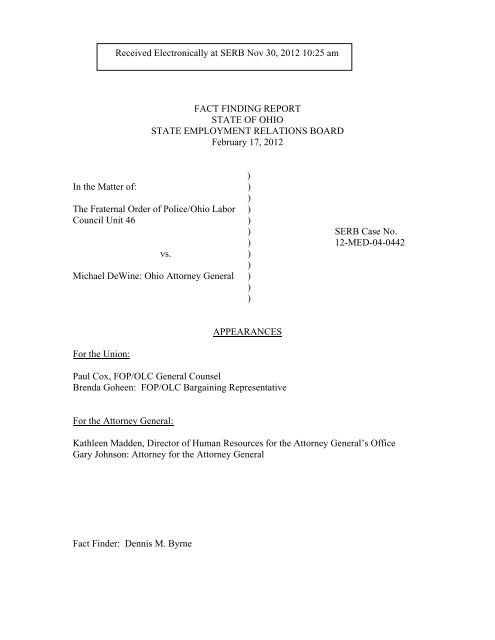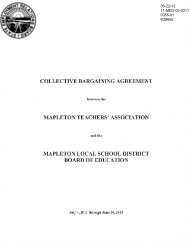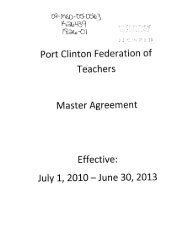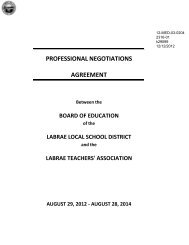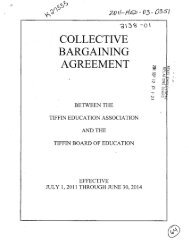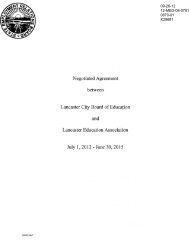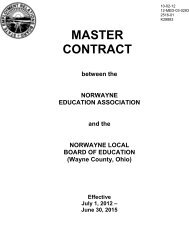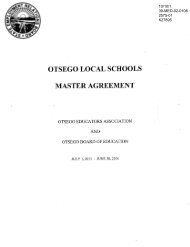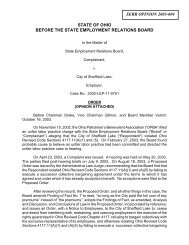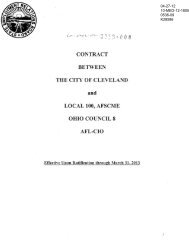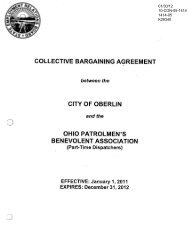FACT FINDING REPORT - State Employment Relations Board ...
FACT FINDING REPORT - State Employment Relations Board ...
FACT FINDING REPORT - State Employment Relations Board ...
Create successful ePaper yourself
Turn your PDF publications into a flip-book with our unique Google optimized e-Paper software.
Received Electronically at SERB Nov 30, 2012 10:25 am<br />
<strong>FACT</strong> <strong>FINDING</strong> <strong>REPORT</strong><br />
STATE OF OHIO<br />
STATE EMPLOYMENT RELATIONS BOARD<br />
February 17, 2012<br />
)<br />
In the Matter of: )<br />
)<br />
The Fraternal Order of Police/Ohio Labor )<br />
Council Unit 46 )<br />
) SERB Case No.<br />
) 12-MED-04-0442<br />
vs. )<br />
)<br />
Michael DeWine: Ohio Attorney General )<br />
)<br />
)<br />
For the Union:<br />
APPEARANCES<br />
Paul Cox, FOP/OLC General Counsel<br />
Brenda Goheen: FOP/OLC Bargaining Representative<br />
For the Attorney General:<br />
Kathleen Madden, Director of Human Resources for the Attorney General’s Office<br />
Gary Johnson: Attorney for the Attorney General<br />
Fact Finder: Dennis M. Byrne
2<br />
Background<br />
The fact-finding involves the approximately one hundred and sixty-five (165)<br />
members of the Fraternal Order of Police/Ohio Labor Council (FOP/OLC) Unit 46<br />
(Union) and the Ohio Attorney General, Michael DeWine (Employer). Prior to the Fact<br />
Finding Hearing, the parties engaged in a number of negotiating sessions; but they were<br />
unable to come to an agreement, and four issues remain on the table: 1) an increase in the<br />
base wage rate for the prospective contract; 2) “Me Too” language with respect to other<br />
similarly situated employees in the Attorney General’s Office; 3) the number of vacation<br />
hours that can be converted to cash; and 4) the clothing allowance.<br />
Because of the impasse, a Mediation/Fact Finding Hearing was held on November<br />
7, 2012 at the Rhodes Office Tower in Columbus. The hearing commenced at 10:00<br />
A.M. and ended at approximately 3:00 P. M.<br />
The Ohio Public Employee Bargaining Statute sets forth the criteria the Fact<br />
Finder is to consider in making recommendations in Rule 4117-9-05. The criteria are:<br />
(1) Past collectively bargained agreements, if any.<br />
(2) Comparison of the unresolved issues relative to the employees in the<br />
bargaining unit with those issues related to other public and private employees<br />
doing comparable work, giving consideration to factors peculiar to the area<br />
and classification involved.<br />
(3) The interest and welfare of the public, and the ability of the public employer<br />
to finance and administer the issues proposed, and the effect of the<br />
adjustments on the normal standards of public service.<br />
(4) The lawful authority of the public employer.<br />
(5) Any stipulations of the parties.<br />
(6) Such other factors, not confined to those listed above, which are normally or<br />
traditionally taken into consideration in the determination of issues submitted<br />
to mutually agreed-upon dispute settlement procedures in the public service or<br />
private employment.
3<br />
Introduction:<br />
This negotiation presents a somewhat unusual situation because the parties<br />
reached a tentative agreement on a new contract, but that agreement was overwhelmingly<br />
rejected by Unit 46’s membership. The Union believes that the <strong>State</strong>’s financial<br />
condition has improved over the past years, and that the <strong>State</strong> can afford to increase the<br />
wages and benefits paid to the membership. The Employer agrees that the <strong>State</strong>’s<br />
financial condition has improved, but argues that it has not fully recovered from the<br />
recession that affected all <strong>State</strong> and Local governments. The <strong>State</strong> contends that it must<br />
continue its cost containment strategy for the duration of this agreement. Therefore, the<br />
Employer argues that it cannot meet the Union’s financial demands.<br />
This difference in outlook about the <strong>State</strong>’s financial condition is at the heart of<br />
the dispute. However, the fact that the parties reached a tentative agreement that was<br />
rejected by the membership complicates the attempt to reach a new agreement. The<br />
Union stated that its membership had made numerous concessions in prior contracts, and<br />
that its membership had not received a general wage increase in six (6) years. The Union<br />
argued that its membership deserved wage and benefit improvements over the life of the<br />
proposed contact. Consequently, the Union stated that the membership’s rejection of the<br />
tentative agreement was justified by 1) the financial reality in Ohio, and 2) the <strong>State</strong>’s<br />
positions on many issues.<br />
The Employer stated that it had bargained in good faith and worked toward an<br />
agreement that was similar to the agreements signed by other state employees. That is,<br />
the Employer believes that the agreement that was negotiated is reasonable and that the
4<br />
terms of the prospective agreement should be similar to the terms of the rejected tentative<br />
agreement.<br />
Contract rejection is a fact of life in industrial relations. However, depending on<br />
the underlying reasons for the rejection, it can cause problems for the parties when they<br />
try to finalize a new contract. Assuming that there was no bad faith or strategic behavior<br />
during the negotiations that led up to the rejected agreement, there is no reason to expect<br />
that subsequent negotiations will lead to a markedly different result. That is, the<br />
underlying reality of collective bargaining is that each side negotiates in a way that will<br />
maximize their gain. At certain times, either the Union or the Employer will have more<br />
bargaining power and negotiate a contract that is beneficial to its principals, i.e., it wins<br />
the negotiation. However, the underlying reality of negotiations is that each side does as<br />
well as it can to advance its goals given the external environment which determines<br />
relative bargaining power.<br />
If the parties have bargained properly, then each side has compromised on its<br />
positions in the attempt to find a workable agreement. However, if one side or the other<br />
rejects the tentative agreement, that rejection forces the parties to return to negotiations.<br />
If the parties bargained fully and fairly, there is little reason to expect that any new<br />
agreement will be significantly different than the rejected agreement.<br />
There is also a practical problem involved with contract rejection. If an Employer<br />
returns to the table and makes significant changes (concessions) to a tentative agreement,<br />
that “teaches” the Union that it can getter better contract terms by rejecting tentative<br />
agreements. This “trains” the Union to reject tentative agreements, and this makes the<br />
bargaining process more costly and less efficient. Therefore, the only time that a contract
5<br />
rejection should lead to a significantly different result is when the rejection<br />
fundamentally changes the bargaining power relationship between the parties. In that<br />
case, the new contract may (emphasis added) lead to changes the terms of the prospective<br />
agreement.<br />
What this means is that if bargaining committees that fully and fairly represent the<br />
demands of their constituencies when they negotiate a contract, a revised agreement will<br />
usually closely resemble the rejected agreement. That seems to be the situation present in<br />
these negotiations. Both sides attempted to craft an agreement that was as beneficial as<br />
possible for their constituents. The Union membership rejected the agreement, but that<br />
rejection does not change the underlying facts of the situation.<br />
The forgoing paragraphs discuss the theoretical and practical implications of one<br />
side or the other rejecting a tentative agreement. With that as a background, the issues at<br />
impasse will be discussed.<br />
Issue: Article 45: Wages<br />
Union Position: The Union demand is for a one (1.0%) percent increase in each year of<br />
the prospective agreement.<br />
Employer Position: The Employer rejects the Union’s demand and countered with a<br />
wage freeze for the life of the agreement.<br />
Discussion: Unit 46 is the last bargaining unit to sign an agreement with the Employer.<br />
In all other settlements, the parties agreed to a wage freeze for the life of the agreement.<br />
One of the criteria that ORC4117 requires a Fact Finder to consider is internal<br />
comparability. In this instance internal comparability is a major factor in the Fact
6<br />
Finder’s decision. Because all other bargaining units have agreed to a wage freeze, a<br />
pattern breaking agreement between the Employer and Unit 46 would have repercussions<br />
far beyond the confines of the present contract. In addition, all other bargaining units<br />
facing the same situation as Unit 46 agreed to the Employer’s position. The Fact Finder<br />
did not receive any evidence that convinced him that Unit 46’s position was so unique<br />
that it deserved a base wage increase when all other bargaining units agreed to a wage<br />
freeze.<br />
The Union was aware of the other settlements and in its discussion of this issue<br />
made the point that it had gone a number of years with no wage increase. In addition, the<br />
step increases found in the contract had also been frozen. The Union negotiating team<br />
argued strenuously that the membership deserved some monetary increase in the contract.<br />
The Union understood that other bargaining units had accepted a wage freeze, but it<br />
believed that even if wages were frozen, that its membership deserved some monetary<br />
increase(s) during the life of the contract. In this context the Union stressed that the<br />
<strong>State</strong>’s fiscal condition was continuing to improve.<br />
Finding of Fact: A wage freeze is the norm for <strong>State</strong> bargaining units.<br />
Suggested Language: Current Contract Language<br />
Issue: Article 45 - Wages<br />
Union Position: The Union demands that “Me Too” language be inserted into the<br />
contract with regard to wage changes.<br />
Employer Position: The Employer rejects the Union’s demand.
7<br />
Discussion: The Union believes that there is a non-trivial possibility that some members<br />
of the Attorney General’s exempt staff will receive a wage increase after negotiations are<br />
completed. The Union also believes that some other individuals will be reclassified as a<br />
way to skirt the contract’s wage freeze language. The Employer went on record and<br />
claimed that there were no plans to raise wages within the Attorney General’s Office.<br />
This is a somewhat complex matter. The Attorney General’s labor force is drawn<br />
from many different occupations. Unit 46 consists of member of the Bureau of Criminal<br />
Investigation (BCI). However, there are secretarial and clerical staff, maintenance staff,<br />
Administrative personnel, and profession staff including attorneys. A “Me Too” clause<br />
usually relates to other organized employees. That is, in a multiunit jurisdiction there is<br />
often an agreement that the wages negotiated by one unit will apply to all units. In<br />
addition, certain benefits are subject to either an implicit or explicit “Me Too” clause.<br />
Health insurance is an example. Usually an employer has a single medical plan and any<br />
negotiated changes in the plan are meant to apply to the entire workforce.<br />
In this situation the Union is convinced that either some individuals will be<br />
reclassified or that raises will be given to members of the BCI who are not covered by the<br />
contract. The Union believes that its members should receive the same raises that are<br />
given to any other employee. The Fact Finder agrees with that argument. However, the<br />
devil is in the details. First, there are entire classifications of employees who are not<br />
covered by a contract and who work in Attorney General’s Office. For example, the<br />
legal staff is in an entirely different classification than the members of the BCI. There is<br />
a legal labor market and the Attorney General’s Office must pay competitive salaries<br />
within that market.
8<br />
Therefore, the coverage of a “Me Too” clause must be restricted to similarly<br />
situated employees. That is, individuals who work in the same or similar labor markets<br />
to the BCI. That means that the “Me Too” language would apply to other unionized<br />
employees and nonunionized members of the BCI. Consequently, the Fact Finder is<br />
recommending the inclusion of “Me Too” language into the contract for other similarly<br />
situated employees.<br />
Finding of Fact: The contract should include a “Me Too” clause with respect to<br />
similarly situated employees.<br />
Suggested Language: Article 45.1<br />
The Language that was agreed to in the previous T.A.<br />
Issue: Article 33 – Vacation Leave Conversion<br />
Union Position: The Union demand is for the right to covert up to one hundred (100)<br />
hours of accrued sick leave hours into cash.<br />
Employer Position: The Employer’s position is that an employee can convert up to<br />
eighty (80) hours of accrued sick leave into cash.<br />
Discussion: This issue is one of the more contentious issues dividing the parties.<br />
Vacation leave accrual conversion was cut from eighty (80) hours to forty (40) hours as a<br />
cost saving measure during the term of the previous contract. In negotiations for the<br />
prospective contract, the Employer’s representative offered to increase the vacation<br />
conversion to one hundred (100) hours. When the Union membership rejected the<br />
tentative agreement, the Employer changed its position. The Employer contends that cost<br />
and internal parity considerations necessitated the change. The Union believes that the
9<br />
Employer’s action is unreasonable and that the original agreement should be included in<br />
the contract.<br />
The Employer pointed out that when the Union membership voted to reject the<br />
tentative contract that they specifically voted down all of the tentative agreements. The<br />
Employer was willing to live with its original agreement, but when the tentative contract<br />
was rejected, it was able to change its position on this issue.<br />
With some understanding of the background of the issue, it will now be discussed.<br />
The Union negotiating committee was adamant that the tentative language should remain<br />
in the contract. However, there was some disagreement on the importance of the issue<br />
and its effect on the membership. That is, some members use the benefit ever year and<br />
convert as many accrued vacation hours to cash as the contract allows. Other members<br />
maintain their accrual and cash out their unused vacation time at the time of separation<br />
from service with the Attorney General. There was no consensus on the number of<br />
individuals that fall into each category.<br />
The Union also pointed out that the Employer’s position simply returned the<br />
membership to the preexisting standard. That is, before the fiscal crisis of the last few<br />
years, the membership could convert eighty (80) hours of vacation leave to cash, and the<br />
Employer’s position was for a return to the status quo. The Union believes that it<br />
deserves an increase in some (all) of the economic provisions of the contract because of<br />
the <strong>State</strong>’s brightening financial outlook. Consequently, the Union believes that the<br />
Employer’s position is a return of a benefit that was already in the contract, and does not<br />
improve on the existing benefit. The Union does not see this as a real gain for its<br />
members.
10<br />
This is a situation of equal and competing interests. There is no doubt that the<br />
<strong>State</strong>’s financial condition is improving. Both parties agree on that fact. At the same<br />
time, it is also apparent that the <strong>State</strong>’s finances do not allow for a general across the<br />
board increase in wages and benefits for its employees. The <strong>State</strong>’s contention that<br />
internal parity dictates its stance on this issue is compelling, especially in light of the<br />
discussion that not all members of the bargaining unit convert unused accrued vacation<br />
time. Therefore, the Fact Finder is recommending the <strong>State</strong>’s position on this issue.<br />
Finding of Fact: The number of accrued vacation hours that can be converted to cash<br />
should return to eighty (80) hours.<br />
Suggested Language: Section 33.6 Annual Vacation Leave Conversion.<br />
In the pay period including December 1, 2012, 2013, and 2014, each employee who has<br />
used less than forty (40) hours of sick leave in the previous twenty-six pay periods will be<br />
offered the opportunity to convert to cash any of the employee’s accrued, unused<br />
vacation leave to a maximum of eighty (80) hours at the current rate of pay.<br />
Issue: Article 46 – Pay Supplements – Clothing Allowance<br />
Union Position: The Union made no initial demand in this article.<br />
Employer Position: The Employer in an attempt to reach a settlement offered to increase<br />
the Clothing Allowance.<br />
Discussion: An increase in the clothing allowance is usually demanded by the Union. In<br />
this instance, the Employer offered some concession in an attempt to demonstrate that it<br />
was trying to find a way to reach an agreement. There was little discussion of this issue.<br />
The Fact Finder recommends an increase of $150.00 to the allowance.<br />
Finding of Fact: The clothing allowance shall be increased by $150.00.<br />
Suggested Language: Section 46.2 Clothing Allowance
Employees shall receive a clothing allowance of $650.00 payable in the first pay period<br />
of January 2013, 2014, and 2015.<br />
11
12<br />
Signed this 21 st day of November 2012, at Munroe Falls, Ohio.<br />
Dennis Byrne /s/<br />
Dennis M. Byrne, Fact Finder


